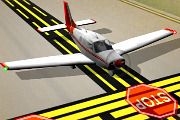
The number of runway incursions has dropped by half for the second year in a row, the FAA says. The number of serious incursions at U.S. airports dropped from 12 in 2009 to six in 2010 (on FAA’s fiscal calendar, 2010 ended on Sept. 30). Half of the incidents involved commercial aircraft, and the other half were general aviation events. The numbers are down drastically from 2000, when 67 serious incursions occurred. To improve those numbers, the FAA has upgraded the signage and markings at airports, improved pilot training on runway conflicts, and installed new technology at some major airports. The FAA said it has also conducted extensive outreach and training for GA pilots. At a news conference last week at Boston’s Logan Airport, FAA Administrator Randy Babbitt said the ultimate goal is zero runway incursions.
“I’m confident that the right combination of education and technology will help us get there,” Babbitt said. Logan has recently completed a 90-day test of a new Runway Status Lights system. The system employs a network of red lights embedded in the airfield pavement to give direct warnings to pilots when it is unsafe to enter, cross or proceed down a runway. Pilots must stop when the red lights are illuminated and may not continue without clearance from air traffic control. The new technology is also being used at Dallas/Ft. Worth, San Diego and Los Angeles. The systems are scheduled to be installed at another 23 airports beginning next year.
The six incursions cited by the FAA for fiscal year 2010 were:
- At Livermore Municipal Airport, in California, on October 24, 2009, a Cessna C152 was instructed to taxi into position and hold on Runway 25R. A Quicki Q200 (an Experimental) was previously cleared to land on Runway 25R. The Q200 landed over the C152 holding on the runway by less than 100 feet vertical and touched down approximately 200 feet down the runway.
- At Charleston AFB, S.C., on December 18, 2009, a Cessna C525 did not hold short as instructed and conflicted with a Canadair CRJ2 on departure roll. The CRF2 maneuvered to pass behind the C525. Closest proximity reported was estimated at 20 feet.
- At Chino Airport, in California, on January 20, 2010, a Piper PA22 was cleared to land on Runway 8R but instead landed on intersecting Runway 3 without clearance. The aircraft continued down the runway through the Runway 8L intersection and under a Aerospatiale AS50 helicopter cleared for Runway 8L. The AS50 overflew the PA22 by 50 vertical feet, the closest proximity reported.
- At Garden City Regional, in Kansas, on March 18, 2010, an airport maintenance vehicle, in pursuit of an animal, entered Runway 35 at Taxiway Charlie without authorization and conflicted with a Cessna C560 Citation. A direct overflight occurred as the truck crossed the runway in pursuit of animal. Closest proximity reported was 50 feet vertical.
- At Phoenix Sky Harbor International, on March 19, 2010, a Cessna C208 was cleared to land on Runway 25L. A Boeing 737 was cleared to take off on Runway 25R. The C208 flew over the 737 and landed on Runway 25R instead of 25L as cleared. Closest proximity reported was 50 to 100 feet vertical.
- At William Hobby Airport, Houston, Texas, on April 28, 2010, a Boeing B737 was cleared for departure on Runway 12R. A controller then cleared a Bell 06 helicopter for north departure from the south ramp with no restrictions. Normally helicopters depart towards the arrival end of Runway 4 and turn north over mid-field and continue northbound. The helicopter departed towards the departure end of Runway 12R, turned southeast crossing over Taxiway November then turned north passing Taxiway Quebec and started to cross Runway 12R when the pilot observed the B737 and turned back toward the southwest. Closest reported proximity was 100 feet vertically and 125 feet laterally.


































